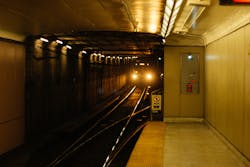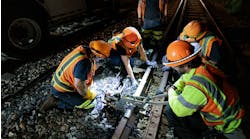FRA announces rail inspection technology rule to improve track safety
A final rule was submitted Aug. 28 by the Federal Railroad Administration (FRA) to allow railroads to use ultrasonic inspection technology, augmented with global positioning system (GPS) technology to employ continuous rail testing.
These updated regulations are expected to improve safety by making it easier for railroads to test rail more frequently and to identify and repair internal rail flaws before conditions degrade safety.
“This rule will allow railroads to use the latest technology to continually monitor safety, which is a big step forward in strengthening safety and reliability on our nation’s railroads,” said U.S. Transportation Secretary Elaine L. Chao.
This regulatory reform allows rail testing vehicles to move without stopping along the track, potentially decreasing passenger and freight train delays associated with routine inspections.
“Transportation Secretary Elaine L. Chao is a strong advocate for safety through innovation, and these modernized standards will allow railroads to implement innovative inspection methods without the burden of applying for individual waivers with well-established safety records,” said FRA Administrator Ronald L. Batory.
FRA has issued waivers for the past 10 years, allowing larger railroads to develop and utilize this technology, and the updated standards are consistent with the state of the practice.
Between May 2019 and May 2020, there has been a 27-percent reduction in broken rail-caused train accidents, which is largely attributable to this new technology, says FRA. Providing all railroads the option of using this technology presents an opportunity to improve the industry’s overall safety record.
The Final Rule on Rail Integrity Amendments & Track Safety Standards focuses more on providing performance-based outcomes, rather than prescribing exactly how companies conduct effective tests. Railroads will be expected to utilize established methods to conduct required rail inspections, but they will also have the flexibility to utilize new technologies and methods as they are proven safe and effective.
Continuous rail testing involves rail cars outfitted with ultrasonic and GPS technologies to internally examine rail without stopping. These cars travel along track, collecting detailed imaging and location data. Companies then transmit the information to test monitoring sites where analysts scrutinize the data to identify suspected internal rail defects. Depending on the severity of the potential defect, carriers have between 36 and 84 hours to dispatch teams to the site to inspect the rail. If a suspected defect is verified, FRA regulations require the railroad immediately apply the proper remedial action. In some cases, this means repairing or replacing the defective rail, slowing trains over the defect or removing the track from service to stop trains until repairs can be made.
Current regulations require ultrasonic rail test vehicles to repeatedly stop and manually inspect to verify indication of defects within four hours. This frequent starting and stopping can require trains operating in the vicinity to travel at slower speeds, often delaying passenger and freight traffic. Using existing methods, companies are typically able to test about 20 miles of track a day. By contrast, companies employing continuous rail testing are typically able to test 80 to 160 miles of track daily.
FRA estimates that one continuous rail car could replace three to five stop-and-verify test cars. This equates to fewer test cars stopping on tracks, reducing the number of trains that slow to accommodate them. Fewer trains slowing decreases the likelihood of crews exceeding maximum allowable work hours, thus decreasing the expense of unscheduled replacement crews. Ultimately, FRA estimates continuous rail testing could, in 10 years, save the industry $121.9 million.
More frequent data collection will produce new data troves, facilitating more detailed research into how track defects develop and propagate over time and how those issues can be addressed before adversely affecting rail safety.
The final rule takes effect 30 days after publication in the Federal Register. The final rule can be viewed on FRA’s website.


